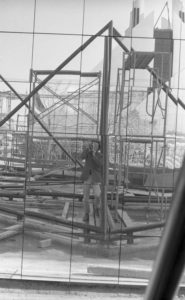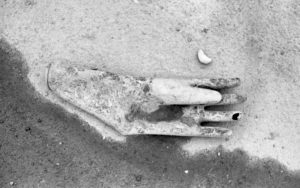17 Nov 2022
Digitizing the Roy Kiyooka Fonds
With funding from the BC History Digitization Program, over 340 images from artist Roy Kiyooka’s photographic practice have been scanned, photographed and shared on the Belkin’s newly developed CollectiveAccess online database. The material is part of Roy Kiyooka’s archives, which were donated to the Belkin by his daughters in the early 2000s. The photographs include final works and research material related to the artist’s foundational projects Expo ’70 (1970), StoneDGloves (1970), Pacific Windows (1990-1997) and 13 Cameras – Vancouver (1979), as well as portraits of local artists and collaborators such as Daphne Marlatt, Fred Wah, Taki Bluesinger and Joy Kogawa. There are also a number of images that provide glimpses into 1960-80s Vancouver and its surrounding areas, in particular the Powell Street Festival, Stanley Park, the PNE, Kitsilano Beach, Waterfront Station and nearby Hornby Island.
 There has been a renewed and justified interest in Roy Kiyooka and his practice, given his significant influence and contributions to the local and national arts and political landscape in Vancouver and beyond. This material contributes to a broader understanding of Kiyooka’s practice as a multi-disciplinary artist, the artistic landscape in Vancouver, and the lived experiences of being Japanese-Canadian through the periods of internment, fight for redress and the ongoing concerns of anti-Asian racism.
There has been a renewed and justified interest in Roy Kiyooka and his practice, given his significant influence and contributions to the local and national arts and political landscape in Vancouver and beyond. This material contributes to a broader understanding of Kiyooka’s practice as a multi-disciplinary artist, the artistic landscape in Vancouver, and the lived experiences of being Japanese-Canadian through the periods of internment, fight for redress and the ongoing concerns of anti-Asian racism.
 Roy Kiyooka (1926-1994) was an artist and educator known to have one of the earliest interdisciplinary practices in Canada. His work encompassed painting, performance, sculpture, photography, film, music and poetry. He largely contributed to community organizing and discussions surrounding philosophy, activism and pedagogy. He taught at the Vancouver School of Art (now Emily Carr University) (1960), Nova Scotia College of Art and Design (1971-72), Concordia University (1965-70) and UBC (1973-91). Kiyooka was commissioned to build a sculpture for the Canadian Pavilion at Expo ‘70 in Osaka, Japan, from which he created seminal works such as StoneDGloves and Pacific Windows. Roy Kiyooka was a second-generation Japanese-Canadian and vocalized the experiences of his family’s displacement during the Japanese wartime internment and the ongoing repercussions and impact. His interdisciplinary contributions and discursive teachings had heavily influenced early arts organizations such as Intermedia and blewointmentpress, and artists such as Roy Miki, Henry Tsang, Carole Itter, George Bowering and Michael de Courcy. Kiyooka has been recognized for his achievements by being named Officer of the Order of Canada (1978) and receiving a nomination for Governor General’s Literary Award for Pear Tree Pomes (1987).
Roy Kiyooka (1926-1994) was an artist and educator known to have one of the earliest interdisciplinary practices in Canada. His work encompassed painting, performance, sculpture, photography, film, music and poetry. He largely contributed to community organizing and discussions surrounding philosophy, activism and pedagogy. He taught at the Vancouver School of Art (now Emily Carr University) (1960), Nova Scotia College of Art and Design (1971-72), Concordia University (1965-70) and UBC (1973-91). Kiyooka was commissioned to build a sculpture for the Canadian Pavilion at Expo ‘70 in Osaka, Japan, from which he created seminal works such as StoneDGloves and Pacific Windows. Roy Kiyooka was a second-generation Japanese-Canadian and vocalized the experiences of his family’s displacement during the Japanese wartime internment and the ongoing repercussions and impact. His interdisciplinary contributions and discursive teachings had heavily influenced early arts organizations such as Intermedia and blewointmentpress, and artists such as Roy Miki, Henry Tsang, Carole Itter, George Bowering and Michael de Courcy. Kiyooka has been recognized for his achievements by being named Officer of the Order of Canada (1978) and receiving a nomination for Governor General’s Literary Award for Pear Tree Pomes (1987).
We are grateful to the UBC Irving K. Barber Learning Centre and BC History Digitization Program for their support of this important project.
Search Roy Kiyooka in the online Collection Database.